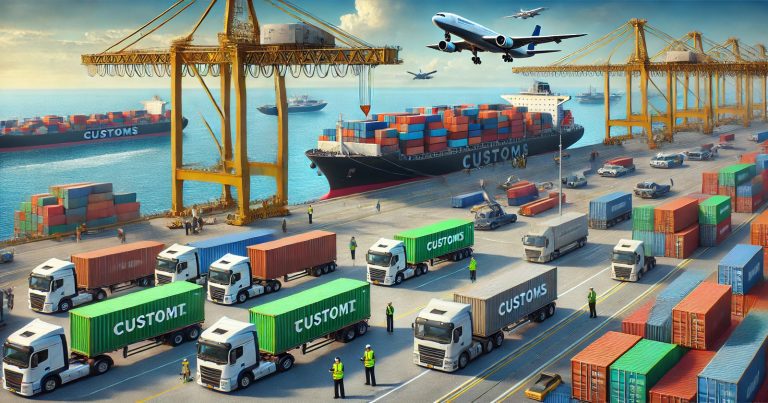Import trade is an essential part of India’s economy, through which businesses from that country can procure goods and services offered by foreign governments to meet domestic demands. Legal and Regulatory Procedure: It involves obtaining the Importer Exporter Code, necessary licenses, payment arrangement, shipping, and customs clearance, along with the final distribution process in India. In this regard, the legal system ensures trade prevents the illicit import of items and even prevents taxation upon imported goods.
International trade businesses need to understand the procedure for importing goods into India. This article attempts to explain, in detail, the import procedure, including customs duty, documentation requirements, licensing conditions, and transport procedures.
What is Import Trade?
Import trade is purchasing goods or services from other countries for consumption, resale, or industrial use in India. Countries import products to fulfil demands that cannot be met domestically because of limited resources, technological constraints, or cost efficiency. Importing helps businesses access high-quality products, advanced technology, and essential raw materials for industrial and economic growth.
India imports crude oil, gold, electronics, pharmaceuticals, and machinery, among other products. Imports support industrial sectors, infrastructure projects, and consumer markets. The Indian government controls import trade through trade policies, customs duties, and licensing systems so that transactions are smooth and legal.
Types of Import
Based on the nature and purpose of imports, India’s import trade can be categorised into the following broad categories:
- Consumer Goods Imports: These are completed products, including electronic goods, clothes, and automobiles.
- Capital Goods Imports: Machinery, tools, and equipment in industrial production.
- Raw Material Imports: Raw materials such as crude oil, iron ore, and chemicals needed in the manufacturing process
- Service Imports: Foreign services that include consultancy, software development, and financial services
All types of imports undergo a defined process to satisfy the government and foreign trade policy.
Procedure of Import Trade
An import procedure in India is a series of legal and administrative procedures concerning importing goods in India. Once import licenses are awarded, the importer’s warehouse will receive only the goods on offer. Thus, These stages must ensure that fraud is avoided, tax compliance is assured, and quality standards are met.
Step 1: Obtain an IEC
An IEC is a 10-digit registration number issued by the Directorate General of Foreign Trade. Any business or individual desirous of engaging in import trade should mandatorily have this code. Without this IEC, customs authorities will not process shipments, and banks will not authorise international payments.
Application for the IEC
- To obtain an IEC, businesses should:
- Register on the DGFT website and fill in the IEC application form ANF-2A.
- Essential business documents include a PAN card, GST registration, and bank details.
- The application fee will be paid online.
- Present the application and await approval.
An IEC, once issued, is lifelong unless cancelled or surrendered. An importer must inform us of any change in business ownership and address changes in the IEC details.
Step 2: Import Policy and Other Restrictions
India controls import by categorising imported commodities into three types:
- Freely Importable Goods – Those goods do not require any license or special permits.
- Restricted Goods – Importers must obtain specific licenses before importing these items.
- Prohibited Goods – Certain goods, such as hazardous chemicals or banned substances, are not permitted for import.
How to Verify Import Eligibility?
The importers should refer to the FTP and HSN Code to determine if the product they want to import requires special permission. The DGFT website and customs offices provide updated lists of restricted and prohibited goods.
Step 3: Procedure to Get Import Licence in India
An import license is also needed for limited goods like medical equipment, defence products, and chemicals. Imports of these items without the proper permit might attract legal penalties and shipment confiscation
How to Get an Import License?
- access the DGFT website and apply online for an import license
- give the details of your products, supplier, and reason for importing
- pay the current application fee.
- Awaiting approval from the DGFT may take a few weeks.
- Once accepted, the import license indicates the quantity and period allowed for the import transaction.
Step 4: Issue an order and Make Payment.
The terms of payment between the importer and the foreign supplier are agreed on even before making a final order. The following are available payment modes:
- Advance Payment: The importer pays before shipment.
- Letter of Credit (LC): The Bank ensures payment is made upon shipment delivery.
- Documentary Collection: The payment is made after checking the shipping documents.
RBI controls international transactions to prevent financial fraud and compliance with foreign exchange policies. Payments made by the importers should be according to RBI guidelines regarding payment to the foreign supplier.
Step 5: Shipping and Needed Documents
Once an order is placed, the foreign supplier ships along with some documents needed for customs clearance. Such documents include:
- Commercial Invoice: Lists the transaction, which includes description, value, and quantity of products.
- Packing List: Provides details on the packaging, size, and weight.
- Bill of Lading (BOL): A shipping carrier-issued document stating the details of a shipment are accurate.
- Insurance Certificate: Any damage that results during transportation is covered.
- Certificate of origin: It indicates the country where the article is manufactured.
Proper documentation ensures that cargo moves without any hitch across customs barriers.
Step 6: Elaborate Import Procedure for India for Customs Duty
When goods reach an Indian port, they are cleared through customs. Importers must lodge a Bill of Entry on the Indian Customs Electronic Data Interchange System (ICES). The customs authority determines the duties according to the product’s HSN Code classification.
Duties and Taxes on Imported Goods
Importers have to pay the following taxes before customs clearance:
- BCD – A fixed percentage as per the category of the product.
- IGST – This is paid based on prevailing GST rates.
- Social Welfare Surcharge – Additional levied on customs duty.
Non-payment of duty leads to detention and penalties on shipment.s
Step 7: Customs Clearance and Final Delivery
The goods to be imported could be inspected physically by the customs officers at importation. These sometimes bring about fines and further litigations on an importer.
Final Transportation and distribution
To this end, the goods are cleared from customs and shipped to the importer’s warehouse. Then, importers must identify port handling, local transportation, and storage facilities. All these transactions must also be documented for tax and audit purposes.
Challenges in India’s Import Process
Importation to India is not always smooth. These complexities can cause the efficiency of trades, rising prices, and delayed shipping. So, importers need to identify those problems and prepare accordingly. Among the main challenging issues concerning India’s import process, listed here are the key ones:
Uncontrollable Document Process
Indian import system involves a series of documents associated with invoices, packing lists, insurance certificates, and government permits. In addition, a Bill of Entry, Importer Exporter Code (IEC), and payment receipts are required to clear customs for the imports. A single error or a missing document might lead to detention or shipment rejection, thereby increasing the time and cost. Importers must maintain proper record-keeping and work with customs brokers for smooth processing.
High Custom Duty and Added Tariffs
Customs duties in India are always based on the product type and the country of origin. Thus, some attract high BCD, IGST, and SWS rates, so the importations are costly. In specific cases, anti-dumping duties are also imposed to avoid over-relating on international products. Importers must always find the last-most-updated customs duty rate before ordering and look into any government trade policies that would reduce the tariffs.
Port Congestion and Logistics Delay
India has significant ports at Nhava Sheva, Chennai, and Kolkata, which are congested with high shipment volumes. Therefore, the ports take more time to unload shipments, so the importers pay higher port charges. Transportation also takes longer. Some easy factors that can disturb supply chains are infrastructure, labour shortages, and unfavourable weather conditions. The importers must factor shipment with maximum lead-time, consider ports with faster clearance rates, and use proper logistics partners to avoid unnecessary delay.
Repeated Changes in Import Policies
India’s trade policies are updated occasionally to safeguard domestic industries and keep the trade deficit in balance. The government brings out new tariff structures, import bans, and strict compliance measures now and then. Such changes affect importers, particularly those dealing with restricted or regulated goods such as pharmaceuticals, electronics, and chemicals. Businesses need to follow the new regulations that come out in FTP updates and customs notifications.
Fluctuations in Foreign Exchange and Payment Problems
Importers have to deal in foreign currencies while making payments to international suppliers. The final cost of imported goods may be affected by the fluctuation in exchange rates. The Reserve Bank of India monitors foreign exchange transactions to prevent illegal financial activities, which sometimes causes delays in fund transfers or additional compliance requirements. Importers should hedge against currency risks using forward contracts or working with banks offering stable exchange rates.
Major Importing Countries of India
The list of countries where India imports any products is not fixed, as it depends upon the availability of a country, price, and quality. Here is a broad perspective of India’s major importing countries and their key imports from each country
| Country | Main Imports |
| China | Electronics, machinery, pharmaceuticals, chemicals |
| United States | Aircraft, medical equipment, petroleum, defence equipment |
| Saudi Arabia | Crude oil, fertilisers, chemicals |
| United Arab Emirates (UAE) | Gold, petroleum, minerals, diamonds |
| Switzerland | Gold, precision machinery, chemicals, watches |
Procedure of Import Trade FAQs
1. How can I get an import license in India?
Online application on the website of DGFT along with all documents and waiting for approval
2. How does one calculate customs duty on imports in India?
It depends on the HSN Code, consisting of BCD, IGST, and any other levied
3. Customs clearance process for imports
Presentation of Bill of Entry, payment of duties, checking by customs, and acceptance for delivery.
4. Is IEC (Importer Exporter Code) mandatory for importation?
Yes, it is compulsorily required by all importers and issued by the DGFT.
5. What are the key steps in the import process in India?
IEC, Import policies, License, Order placement, Payment, Customs clearance, and Transportation of goods.


